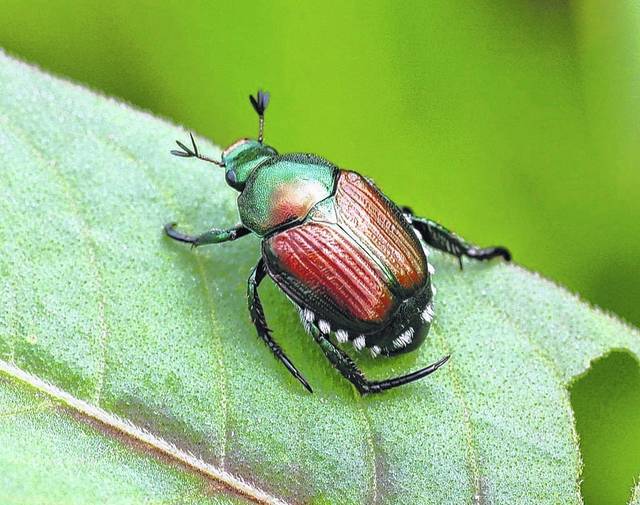Summer allows many people to reap the rewards of all their hard work that was completed in the spring. Fruits are beginning to ripen, gardens are producing vegetables, lawns are lush and green, and ornamental plantings are enhancing the landscape. However, one insect can destroy most of the bounty just a few weeks before harvest, and all your hard work will be for naught.
The Japanese Beetle will soon begin to emerge from the soil and begin to attack and feed on many home and garden plant species. The adult beetles feed on Japanese Maple, Norway Maple, Rose-of-Sharon, Black Walnut, Flowering Crabapple, Apple, Cherry, Plum, Peach, Roses, Elms, Sweet Corn, Pepper, and Grapes. They consume the upper leaf surface between leaf veins which often leaves a skeletonized or lacy appearance. The Japanese Beetle grub lives in the ground and feeds on grass roots, which does significant damage to lawns in the fall and spring seasons.
Adult Japanese Beetles are shiny, metallic green insects with copper colored wings. They are typically .5” long and emerge from the soil in mid to late June, and begin to feed on landscape plants, fruits, and vegetable foliage. During this feeding frenzy, the beetles will mate, and the females will begin to lay eggs in small burrows in the soil near their food source. This behavior will continue for up to 60 days, after which the adult beetles die off. Eggs will begin to hatch within a few weeks of incubation, and small grubs will start to feed on grass rootlets until fall. Japanese Beetle grubs are cream colored with a yellow to brownish head and six legs. They quickly grow to a length of approximately 1”. Once the soil temperature reaches 60°F in fall, the grubs will move deeper into the soil profile and overwinter until the following spring. When the soil temperature begins to warm in the spring, the grubs will move up in the soil and begin to feed on grass roots until they pupate in late spring. After pupation, the adults emerge in late June or early July, and the life cycle is completed.
If you experienced Japanese beetle damage last year, you are very likely to have more damage the following year, due to the beetles’ life cycle and proximity of egg burrows to the feeding area. From a management standpoint, it is important to note that the grubs and adults are causing damage to your landscape and you should have a treatment strategy for both.
To control Japanese beetle grubs, there are several options, including chemical control and biological control. Chemicals labeled for grub worm control in lawns include Sevin, Bifen I/T, Merit, and other combinations of these pesticides. Timing for chemical control is critical and should be applied when grubs are near the surface feeding on grass rootlets. In the spring, the window for treatment is April – June. For the fall, the window for treatment is August – September. The second most important factor affecting the effectiveness of chemical control is irrigation. Irrigation should be completed before the chemical application to increase moisture in the soil, which helps to bring grubs near the surface. You should then water in the chemicals after the application with a second irrigation, which helps carry the pesticide into the root area where the grubs are feeding. Note that Sevin is the only chemical that should not be watered in after applying.
If you prefer not to apply pesticides, you can use a biological control of milky spore bacteria. These bacteria infect the grubs and produce a disease which will eventually kill them. These spores work best when applied in late September through early October. Some brand names are Doom, Japeidemic, or Milky Spore.
For adult Japanese Beetles, begin treatments when beetles or damage is first observed. Contact insecticides offer immediate knockdown and should be sprayed thoroughly onto the foliage. Brand names are Seven, Orthene, Tempo, Bayer advanced Lawn & Garden Multi-Insect Killer, Talstar, Cyanora, and Sprectracide Bug Stop Multi-Purpose Insect Control Concentrate. Repeated applications may be necessary due to the short residual effect of the pesticides. A second adult Japanese beetle control method is a soil applied drench of Merit. This is a systemic pesticide and will translocate into the plant and kill the adults as they feed on the leaves.
As with all pesticides, read the label thoroughly before use, apply at recommended rates and times, do not apply on windy days, and do not apply when bees are actively foraging or present.
Don’t forget that the Sampson County Extension Service is offering the Sampson County Friends of Horticulture program this year. This program offers monthly “How To” horticultural seminars targeting homeowners and gardeners of Sampson County. Our next session will cover information about bees – what you should know about these important pollinators, on June 15 at 6 p.m. at the Sampson Extension Center. Pre-register by calling 910-592-7161. The registration fee is $5 per session, and you only pay for the session that you want to attend.
The use of brand names and any mention or listing of commercial products or services in this publication does not imply endorsement by North Carolina State University nor discrimination against similar products or services not mentioned.


